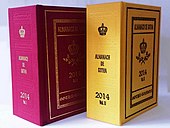Gothaischer Hofkalender
Gothaischer Hofkalender was the name of a series of books by Justus Perthes Verlag, named after the place where it was published, Gotha, and became world-famous as "the Gotha".
history
The court calendar was first published in 1763 by Johann Christian Dieterich and since the mid-1780s by CW Ettinger in Gotha under the title "Gothaischer Hof-calender set up for use and pleasure". It developed from the almanac nécessaire published in 1763 by the chamber president of the Duchy of Saxony-Gotha-Altenburg , Wilhelm von Rotberg . However, as early as 1785 Ettinger leased his rights to the publication of the court calendar to Justus Perthes , who was only allowed to publish and publish this work under his own name from 1816. Its founder was the theologian Emanuel Christoph Klüpfel . Until the time of the Second World War in 1944, the calendar was updated and supplemented in terms of content in annual editions with different titles that were always slightly changed - "Gothaischer Genealogical Calendar", "Gothaischer Genealogischer Hof-Kalender" or "Gothaer Hof-Kalender" . After that, the city of Gotha was in the GDR .
French edition
A French edition - known as "Le Gotha" - appeared from 1764 under the title Almanac (h) de Gotha , first by Ettinger and then also by Perthes.
In both editions, news about regents and their families was initially only compiled as a small part of the calendar content, reports were also given on the envoys to the residences of Europe and - in addition to a general and astronomical calendar - essays on historical events and people were also included.
It was not until the 1820s that “der Gotha” emerged as a genealogical reference work, the explicit and conscious successor to the New genealogical-schematic Reichs- und Staats-Handbuch , first published by Varrentrapp and Wenner in 1742 , which had appeared in 64 editions by 1811.
Since then, information has been given about the living members of the ruling houses from Europe (I. Department), about other princely houses of Europe (II. Department) and about the German, formerly imperial count families (III. Department).
In addition, each year under the name "Diplomatic-Statistical Yearbook" contained detailed information on the sovereign states of the world, with information and a. About population numbers, state budgets, state dignitaries, diplomatic and consular officials, military affairs, etc.
Since 1824, the ruling and princely families listed in the “court calendar” (i.e. the high nobility ) have been divided into three groups:
- current sovereigns and their homes
- other princely houses, especially from Germany, France and Italy
- as equal to the princely houses , mediatized count houses (gentlemen)
Later was "court calendar" nor the four rows of paperbacks of the count's houses (since 1825), the baronial houses (since 1848), the noble ( uradeligen ) Houses (since 1900) and the letter noble expanded houses (since 1907).
Since 1876/1877 the division has been changed again, in that after the first division (regents and their families) the second division now grouped the German, stately (princely and counts) houses and in the new third division other princely families from Germany and Europe were shown.
Since 1939 the actual “Gothaische Hofkalender” - dispensing with a calendar - appeared only as a “Gothaisches genealogical pocket book”.
In 1951, its function was taken over by the Genealogical Handbook of the Nobility from Starke Verlag , which kept the division into princely (3 departments), counts, baronial and aristocratic houses and since then has published several volumes annually by the German Aristocratic Archives.
After 1989, the Justus Perthes family granted a license to use the name Almanach de Gotha , the former French-language series, to the London company Almanach de Gotha Limited . This was the first time an English language “184. Edition "as Volume I , which contains the updated genealogies of the ruling, formerly ruling and mediatized royal houses of Europe and Brazil . Volume I continued in 1999, 2000, 2003 and 2004 and again in 2012 and 2013 . In 2001 a volume II was also published , which contains other European ducal and princely houses (comparable to the third section of the old Gotha court calendar and the volume series Princely Houses of the Genealogical Handbook of the Nobility ).
In 2015 the “Almanach de Gotha” was published again under this name ( Gothaisches Genealogisches Handbuch ) for the first time since 1944 by the “Stiftung Deutsches Adelsarchiv”, which in 2013 acquired the naming rights to the “Almanach de Gotha” from the publisher Ernst Klett Stuttgart (as legal successor of the “Almanach de Gotha” since taking over the publishing house “Justus Perthes / Haack Gotha” in 1992).
See also
literature
- York-Gothart Mix: Genealogical calendar as a medium of European identity. In: Hans-Jürgen Lüsebrink u. York-Gothart Mix (Ed.) In collaboration with Jan Fickert u. Bianca Weyers: French almanac culture in the German-speaking area (1700–1815). Generic structures, comparative aspects, forms of discourse. V&R unipress, Bonn University Press 2013, pp. 35–50.
Web links
- Almanach de Gotha / Gothaischer Genealogischer Hofkalender , published from 1785 to 1944 by Justus Perthes, Gotha
- Gothaische Genealogische Handbuch - GGH , new editions from 2015 in the publishing house of the Deutsches Adelsarchiv
- Werner Paravicini: Handbook for the self-assurance of the nobility. In: Frankfurter Allgemeine Zeitung, September 19, 2015
Individual evidence
- ↑ s. Gothaischer genealogical court calendar together with diplomatic-statistical yearbook for the year 1863, 100th year, SV online
- ↑ Werner Greiling : The unleashed market: publishers and book publishers in the Thuringian-Saxon cultural area around 1800 . Leipziger Universitätsverlag, Leipzig 2004, ISBN 3-936522-87-1 , p. 110.
- ^ Albert Schumann : Klüpfel, Emanuel Christoph . In: Allgemeine Deutsche Biographie (ADB). Volume 16, Duncker & Humblot, Leipzig 1882, pp. 255-257.
- ↑ Christophe Duhammele: Le Gotha: Cabinet des titres de l'aristocratie européenne, In: l'Europe, encyclopédie historique . Ed .: Christophe Charle, Daniel Roche. Éditions des Actes Sud, Arles 2018, ISBN 978-2-330-10643-0 , pp. 996 f .


